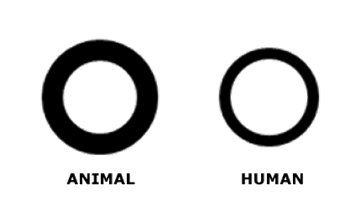This blog entry really should have been my first. What I mean by this is what exactly is physical anthropology and what does a physical anthropologist do? In the following blog I will cover different professions in physical anthropology, and what to do to become a successful physical anthropologist.
Now, physical anthropology is usually thought of as forensic anthropology and vice versa; this is not the case. Just like physical anthropology is a sub-field of anthropology, physical anthropology has its own sub-fields; one of which is forensic. The others are human biology, primatology, paleoanthropology, skeletal biology and osteology, and paleoanthology. These terms are pretty self explanatory...that is all except osteology. Osteology is, plain and simple, the study of bones, and in the case of physical anthropology, human bones. I am sure that you have seen in crime shows when they know whether the bone is human or animal, the way they figure this out is by working with actual bones. I use the phrase “actual bones” because some undergraduate colleges have replicas. These replicas will not work when trying to learn how to differentiate what is human and what is not. For example the macrostructure (overall structure) of the cortical bone (the outer surface of the bone), in humans is porous, more so than that of an animal. This level of detail cannot be replicated, and if it can, plastic feels and looks nothing like real bone.
(The image below: "“relative thickness of animal and human diaphysis (the shaft or central part of a long bone) cortical bone")
Now, physical anthropology is usually thought of as forensic anthropology and vice versa; this is not the case. Just like physical anthropology is a sub-field of anthropology, physical anthropology has its own sub-fields; one of which is forensic. The others are human biology, primatology, paleoanthropology, skeletal biology and osteology, and paleoanthology. These terms are pretty self explanatory...that is all except osteology. Osteology is, plain and simple, the study of bones, and in the case of physical anthropology, human bones. I am sure that you have seen in crime shows when they know whether the bone is human or animal, the way they figure this out is by working with actual bones. I use the phrase “actual bones” because some undergraduate colleges have replicas. These replicas will not work when trying to learn how to differentiate what is human and what is not. For example the macrostructure (overall structure) of the cortical bone (the outer surface of the bone), in humans is porous, more so than that of an animal. This level of detail cannot be replicated, and if it can, plastic feels and looks nothing like real bone.
(The image below: "“relative thickness of animal and human diaphysis (the shaft or central part of a long bone) cortical bone")
For those who feel like the action is out in the field, physical anthropology might be what you are looking for. An extreme example of this is applied anthropometry. In this profession, you get to work in places you never thought would need a physical anthropologist. “In the public sector, job openings in applied anthropometry are concentrated in the military.” And there are some where you could see how the skills of a physical anthropologist would be vital; like the zoo. As I stated before, one sub-field of physical anthropology is primatology. I know what you may be thinking, that all physical anthropologist have to do is play with them...but you could not be more wrong. Some zoos have endangered primates, and it is the resident physical anthropologist to create and oversee captive breeding programs. However cool these jobs sound the most vital profession a physical anthropologist can have, in my opinion, is in academics. These academic jobs can vary from undergraduate to graduate even to teaching at medical schools.
School...this is the most important word to any budding anthropologist no matter what sub-field they want to go into. Well..school, studying, and good grades. I am not here to lecture you or go all preachy about how important school is but...for me it always has been about school. But that semester where I had into to physical anthropology, I fell even deeper in love with anthropology. I still find it so weird how the thing I want to do with my life was literally inside of me this whole time. And I owe it all to the first physical anthropology professor I have had, and so far the only one. I truly wish that in my life I will have many more who are able to effectively teach this art...this art called physical anthropology.
Please feel free to comment on what you thought of the blog, or other physical anthropological subjects you would like me to cover.
School...this is the most important word to any budding anthropologist no matter what sub-field they want to go into. Well..school, studying, and good grades. I am not here to lecture you or go all preachy about how important school is but...for me it always has been about school. But that semester where I had into to physical anthropology, I fell even deeper in love with anthropology. I still find it so weird how the thing I want to do with my life was literally inside of me this whole time. And I owe it all to the first physical anthropology professor I have had, and so far the only one. I truly wish that in my life I will have many more who are able to effectively teach this art...this art called physical anthropology.
Please feel free to comment on what you thought of the blog, or other physical anthropological subjects you would like me to cover.

 RSS Feed
RSS Feed
